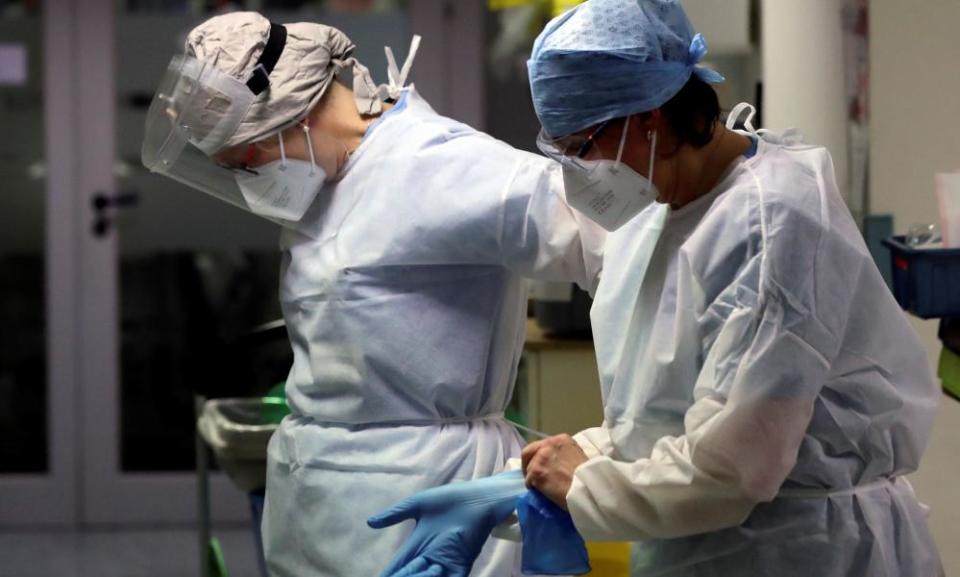Belgium cancels non-urgent surgery as full Covid lockdown looms

Belgium has inched closer to a second national lockdown with new “harsh measures” as all non-urgent surgeries were suspended for a month from Monday to give hospitals breathing space in the face of spiralling coronavirus infection rates.
Belgium’s new prime minister, Alexander De Croo, said he would put a protective ring around the health system, as he announced further restrictions on Friday morning in the few areas of public life left relatively open.
Amateur sports events will be suspended and amusement parks closed. There will be a 20% cap imposed on the normal size of higher education classes. Working from home when possible is also mandatory. The country’s bars and restaurants will remain closed, De Croo said.
“Working from home is the rule. And the rule is the rule”, the federal health minister, Frank Vandenbroucke, told Belgium’s business community.
In a notable moment in the country’s crisis, Belgium’s prime minister said he believed it was still within the power of the Belgian people to avoid a second full national lockdown involving the shutting of schools and non-essential shops.
“These are harsh measures that severely limit the freedom of everyone”, De Croo said. “I understand that people have questions, but the main goal is that our GPs and hospitals can continue to do their jobs, that our children can continue to go to school, that our companies can keep working, and that the mental health of people can be as good as possible is protected.”
But the scientist who acts as the interfederal spokesman on the Covid-19 crisis, Yves Van Laethem, had offered a clear steer as to the government’s thinking on Thursday evening when he was asked whether a lockdown will be necessary if the infection figures do not reduce within a week.
“In short, probably yes”, Van Laethem had said. “Indeed, if in the middle of next week, between Tuesday and Thursday, we do not have a clear inclination of the various curves, and that we therefore risk continuing in a completely negative manner, as we can see for the moment , something more must be done. And more than what we’re doing right now, one way or another, it’s a form of containment.”
Belgium had only last month been cited by the UK health secretary, Matt Hancock, as a model of how to deal with the second wave of infections, after numbers were kept down in August.
He had suggested that the Belgian policy of limiting people’s interactions within small “social bubbles” had been effective as he sought to convince the British public of the utility of the “rule of six” in the UK.
The figures in Belgium shot up, however, as people returned to work from their August break. The government also repeatedly fiddled with its initial policy of each household being able to socialise with a second of four people, changing the size of the social bubble over time, creating confusion.
Bars and restaurants were then reopened – before the government decided to close them again and only allow places that served food to continue. This created some instances where bar staff printed fake menus to be handed out to customers as a cover for continuing to operate.
The test-and-trace system has also been overwhelmed with the government being forced to announce that they would no longer test those who were now showing symptoms due to the lack of laboratory capacity.
Speaking on Friday, shortly after the prime minister’s appeal to the nation, Van Laethem told reporters that 49 people had died on Monday. Between October 13 and 19, the virus killed more than 35 people on average each day, up 13% on the previous week.
“Who stays at home can save lives“, he said. “We expect over the next week to exceed 20,000 new cases a day. The number of infections and hospitalisations continue to increase across the country. Brussels and Wallonia are currently the most affected regions in Europe.”
The average number of daily infections in Belgium between 13 and 19 October was 10,454, an increase of 69% on the previous week. There an average of 350 daily hospital admissions, up 82% on the week before.
“We expect over the next week to exceed 20,000 new cases a day,” Van Laethem said. “Concretely, this means that 1% of Belgians would be contagious … What worries us the most are the sharp increases among those over 70 and over 90. There is thus a doubling of cases among those over 70 on a weekly basis and every five days among those over 90. In proportion to their presence in the population, this age category has the second highest infection rate in Belgium, after the 20-30 age group.”
On Wednesday, Belgium’s deputy prime minister, Sophie Wilmès, who ran the country until last month, and who had marked the reopening of restaurants with a photo opportunity with her husband, was taken to intensive care, just six days after going into isolation with symptoms.

 Yahoo News
Yahoo News 